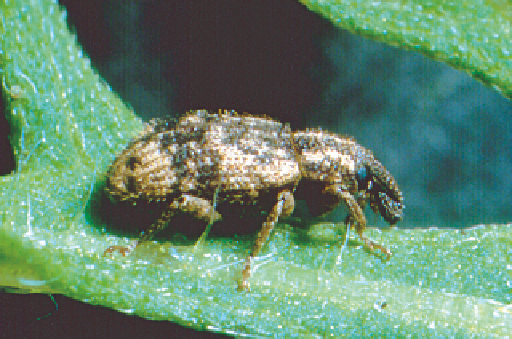Biology Reference
In-Depth Information
Fig. 12.5
Listronotus setosipennis
adult
sites, with 16% of the sites showing high to very high levels (Dhileepan 2003a).
The realised impact of
L. setosipennis
damage in the field in Australia has been less
than the potential impact as estimated through controlled trials, because of higher
number of
L. setosipennis
larvae per plant utilised in the trials (Dhileepan 2003a).
The seed-feeding weevil
Smicronyx lutulentus
Dietz (Coleoptera: Curculionidae)
from Mexico (McClay 1979; McFadyen and McClay 1981) was released in Australia
(McFadyen and McClay 1981) from 1981 to 1983. Field establishment was confirmed
only in 1996 (Dhileepan and McFadyen 1997). Adults feed on young leaves, but cause
negligible feeding damage. Larval feeding causes significant reduction in seed output.
In Mexico up to 30% seed destruction is attributed to
S. lutulentus
damage (McClay
1985). In Australia, the incidence of
S. lutulentus
is sporadic and localised with limited
impact on seed production. With the current low infestation levels it will be difficult to
estimate its impact on parthenium under field conditions (Dhileepan et al. 1996).
The stem-galling weevil
Conotrachelus albocinereus
Fiedler (Coleoptera:
Curculionidae) was introduced from Argentina and Brazil. Adult feeding damage
is not significant, and causes only minor damage to young leaves (McFadyen
2000). Damage is mainly due to larval feeding, which results in the fracturing of
the vertical continuity of vascular tissues, thereby disrupting the host plant's over-
all metabolism (Florentine et al. 2002). Galling often kills axillary shoots, but the
main stem remains unaffected. This insect might have established at a few sites in
central Queensland, but is not in sufficient numbers to indicate widespread field
establishment.
The clear-wing moth
Carmenta
nr
ithacae
(Beutenmüller) (Lepidoptera:
Sesiidae) (Fig. 12.6) collected from Mexico is a highly host-specific agent
(McFadyen and Withers 1997; Withers et al. 1999) and was released in Australia in
1998. Damage is from larvae that feed on the cortical tissue of the taproot and
crown. Larvae are found on all growth stages of parthenium, and heavily infested
plants often die. This agent has been recovered from the field only at irrigated

